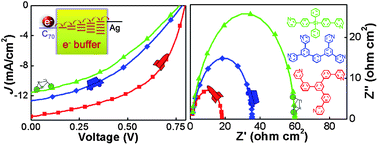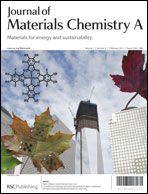The effect of organic electron transporting layers (ETLs) on organic solar cells (OSCs) has been evaluated. Thermally deposited small molecule OSCs utilizing the electron transporting material 2,9-dimethyl-4,7-diphenyl-1,10-phenanthroline (BCP), and the pyridine-containing derivatives 1,3,5-tri(m-pyrid-3-yl-phenyl)benzene (TmPyPB), bis-1,2-(3,5-di-3-pyridyl-phenyl)benzene (B3PyPB) and diphenyl-bis[4-(pyridin-3-yl)phenyl]silane (DPPS) as ETLs have been fabricated and studied. Impedance spectroscopy and current density–voltage characteristics show that the device performance is closely related to the intrinsic electron mobilities of the ETLs. It was demonstrated that the compound TmPyPB, which possesses good thermal properties, high transparency, high refractive index, and low ionization potential, as well as high electron mobility, is a promising material as an ETL in OSCs, resulting especially in lower series resistance and higher shunt resistance. The devices adopting TmPyPB as an ETL show exceptional characteristics with high fill-factor (FF) and very high power conversion efficiency (PCE) up to 53% and 6.3%, respectively, which are great enhancements compared to cells using conventional BCP as an ETL material.


 Please wait while we load your content...
Please wait while we load your content...